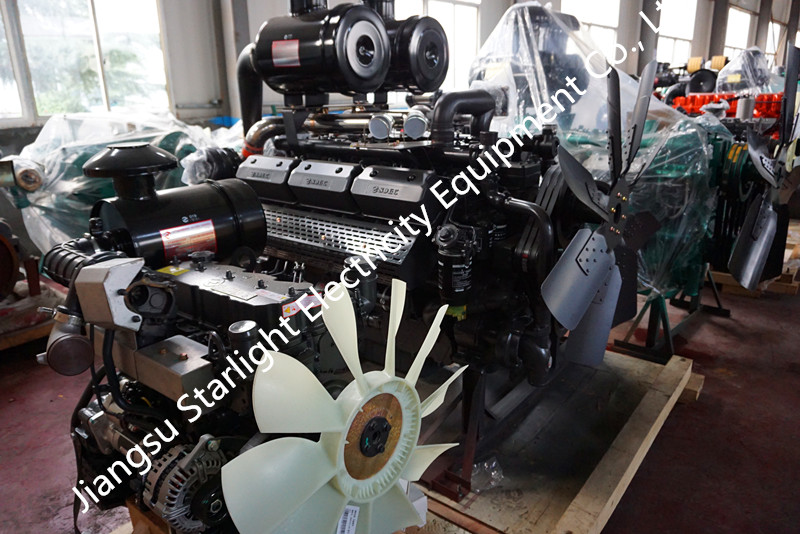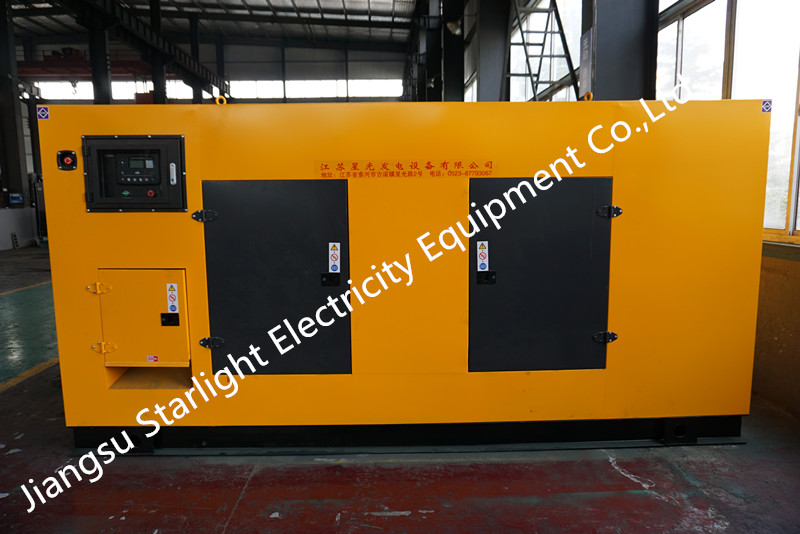This article mainly introduces Shangchai G Series SC27G diesel engine normal starting procedure including cold start, engine operation, engine shutdown and emergency shutdown.
4.5.1 Normal starting procedure
The G series V type diesel engine can be started smoothly at temperature of -5°C and above. Starting procedure is as follows:
● Disengage the diesel engine from the drive system. .
● Put the mechanical operating devices into the 'running' position.
● Push the governor controlling handle to unloaded position with speed at about 900 r/min.
● Insert electric key and turn the switch from the OFF position to the START position to start the engine.if it cannot be started up in 10 seconds, turn the switch from the START position to the OFF position. Make another starting after 2 minutes. If the engine cannot be started up for three times, stop starting and refer to Section 6 for troubleshooting guideline to find cause. Each starting lasts 2 to 3 seconds.
Caution: The engine should be started without load.

● After the engine has started up, the switch key goes back to the ON operation from the START position automatically. The oil pressure gauge should show reading within 15 seconds after the engine has started up; otherwise, stop the engine immediately to prevent damage to the engine and find the causes and remove the fault(s) according to Section 6 Troubleshooting Guidelines.
● Having started up from a hot state, the engine should run at idle for l-3 minutes before being accelerated and loaded gradually. .
● Having started up from a cold state, the engine should run at idle for 3-5 minutes. Increase engine speed slowly to 1,500 r/min and run the engine with partial load. Do not run the engine with full load until the outlet coolant temperature is higher than 75°C, oil temperature 50°C and oil pressure 0.40 MPa.
Caution: Especially starting the engine from a cold stat, increase the engine speed slowly as far as possible to have every bearing adequately lubricated and oil pressure stable.
● Check the instruments during the engine running at idle to see whether they work normally.
Caution: Do not accelerate and load the engine immediately after it has been started up.
Caution: Do not idle the engine for a long period of time or it can cause problems to the engine. When an engine idles, the temperature in combustion chamber is low and combustion is not complete. It can cause carbon deposit in cylinder resulting in block of the orifices of fuel injector, as well as seizures of piston rings and valves, thus leading to engine performance deterioration.
Caution: If the engine is start by a jumper cable, parallel connection of the cable should be adopted by connecting the positive pole to the positive terminal and the negative pole to the negative terminal. If the engine is start by external power supply, the circuit breaker should be set to the OFF position. Take out the key to prevent accidental activation before connecting a jumper cable.
4.5.2 Cold Start
Cold start refers to starting the engine at temperature -50°C. Choose proper cold starting aid to warm the engine according to ambient temperature and then follow the normal starting procedures to start the engine. There are, in general, several ways to warm the engine:
● Warming the engine oil and coolant to 40-50°C;
● Installing a heating device in the air inlet pipe or heating air by fire at the entrance of the air inlet pipe, with which special precaution must be paid for safety;
● Increasing the surrounding temperature of the engine room;
● Using diesel fuel, engine oil and coolant that are suitable for cold areas;
● Warming battery or using battery of larger capacity or having higher discharge rate (special battery for low temperature).
4.5.3 Staring after a longtime stop or replacement of lubricating oil
If the engine hasn't been used for less than 30 days or its engine oil has just been replaced, it is necessary to fill the lubricating system with oil. Crank the engine and make oil enter moving parts. Start the engine only after you feel light when cranking the engine. Finish the following preparation before starting the engine according to the procedures of normal starting or cold starting:
● Check the oil level for being within the dipstick marks range.
● Check the voltage of the battery for abnormality.
● Prime the fuel system. Refer to Section 5.3 for operation.
● In order to have a quick starting of a standby engine for emergency need, start the engine every three to five days and operate it until its engine oil and coolant temperatures reach 60'C and above.
4.6 Engine Operation
Cautions for operation of the engine:
● Pay frequent attention to oil pressure and coolant temperature. In case of any abnormality, stop the engine immediately for inspection.
Lubricating oil pressure:
150 kPa @ idle speed (minimum allowable)
300 kPa @ rated speed (minimum allowable)
500 kPa @ rated speed (maximum allowable)
Coolant temperature:
75-95°C (normal working range)
● When engine overheating starts to happen that is indicated by the coolant temperature alarming, reduce engine speed or load or take the both actions until the coolant temperature falls down into the normal range; otherwise, find the cause and remove the fault as per Section 6 Troubleshooting Guidelines.
● During the operation, especially sudden decrease of load, attention should be paid to avoid the failure of the governor, which can cause sudden increase of engine speed exceeding the defined value (usually called flying away).
Once such case happens, make an emergency stop first and then check for the cause.
Caution: Over-speed running will cause serious damage to the engine.
There are significant signs before most engine faults occur, such as changes in performance, sound, or engine appearance. Listening and observing will help detect in advance or predict some problems of the engine that will occur later, with which the proper measures can be taken in time to eliminate such problems as can lead to a serious engine failure.
Typical engine fault signs:
Engine misrires
Engine vibrates abnormally
Engine sounds abnormal
Engine coolant temperature and oil pressure change abruptly
Engine produces black smoke
Engine power output is insufficient
Engine oil consumption is too much
Fuel consumption is too much
There is leakage of oil, fuel or/and coolant
4.7 Engine Shutdown
4.7.1 Normal shutdown
If the engine has just worked at a high speed and heavy load for a long time, reduce its load and speed gradually and run it at idle for 5 minutes before stopping it to let the engine cool down evenly and turbocharger speed fall considerably so as to protect the engine and turbocharger. Turn off the fuel tank cock after the engine has stopped.
If the engine will not be used for a period of time (6 months at most), keep it properly. Refer to Section 7 for engine storage.
4.7.2 Emergency shutdown
Under emergency or special condition, make an emergency stop to avoid serious engine failure. Manually pulling of the emergency stop handle can achieve an emergency shutdown.
4.8 Running-In of a New or Overhauled Engine
When the engine is new or has been overhauled, run the engine for 60 hours in running-in condition and change its oil thereafter before running it in full load condition so as to improve its moving parts working condition and its reliability and service life.
The way of running-in varies from one engine application and loading manner to another. In principle, engine speed and load in running-in process will be increased gradually with the running-in going on. Load should be 50%-80% of its full one, and speed should not exceed 80% of its rated speed. If the engine is for generator sets with constant speed, it is allowed to run-in at rated speed. However, long time running at idle or with too small load at the beginning of running in is not recommended.
Do not run the engine at idle or with low load for a long-time either in running-in period or normal working period thereafter. Continuous running at idle should not be longer than 10 minutes to avoid early wear due to carbon deposit or engine performance being affected.
The above running-in process with less time should also be required every time the cylinder liner, piston, piston ring connecting rod bearing, main bearings or/and crankshaft are replaced.
Maybe You Also Like Shangchai silent diesel generator set

Copyright © Guangxi Dingbo Generator Set Manufacturing Co., Ltd. All Rights Reserved | Sitemap
Update cookies preferences